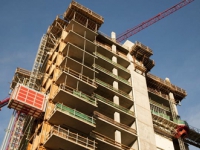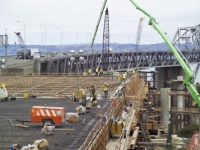Fewer than half of metros add construction jobs in August; Dodge starts, ABI dropEditor’s note: Construction Citizen is proud to partner with AGC America to bring you AGC Chief Economist Ken Simonson's Data DIGest. Check back each week to get Ken's expert analysis of what's happening in our industry.Construction employment, not seasonally adjusted, increased from August 2014 to August 2015 in only 163 (46%) of the 358 metro areas (including divisions of larger metros) for which the BLS provides construction employment data, decreased in 153 (43) and was stagnant in 42, according to an AGC release and map today that analyzed BLS data. (BLS combines mining and logging with construction in most metros to avoid disclosing data about industries with few employers.) The number of metros with job increases was the smallest since late 2011. It is possible that employment gains in some metros were held down by a lack of available workers rather than lack of projects; 86% of the 1,358 respondents to an AGC survey released on September 10 said they were having difficulty filling hourly craft or salaried professional positions.

36 states, D.C. add construction jobs in last year; multifamily, hotel markets remain hotEditor’s note: Construction Citizen is proud to partner with AGC America to bring you AGC Chief Economist Ken Simonson's Data DIGest. Check back each week to get Ken's expert analysis of what's happening in our industry.Seasonally adjusted construction employment rose in 36 states and the District of Columbia from August 2014 to August 2015, declined in 13 states and held steady in North Dakota, an AGC analysis of Bureau of Labor Statistics (BLS) data released today showed. The number of places with year-over-year gains was the smallest since April 2012. California again gained the most construction jobs (43,800 jobs, 6.5%), followed by Florida (25,700, 6.4%), North Carolina (13,200, 7.4%), Washington (12,800, 8.0%) and Texas (11,400, 1.7%). The highest percentage of new construction jobs were again added by Arkansas (14%, 6,200) and Idaho (10%, 3,600), followed by South Carolina (9.1%, 7,500) and Iowa (8.9%, 6,700). The steepest percentage losses again occurred in West Virginia (-15%, -5,100) and Rhode Island (-7.9%, -1,300), followed by Mississippi (-7.4%, -3,600), Ohio (-5.7%, -11,300) and New Mexico (-5.2%, -2,200).
September 22, 2015


Contractors report major difficulty filling craft positions as hiring plans strengthenEditor’s note: Construction Citizen is proud to partner with AGC America to bring you AGC Chief Economist Ken Simonson's Data DIGest. Check back each week to get Ken's expert analysis of what's happening in our industry.Nearly four out of five contractors (79%) are having trouble filling hourly craft professional positions, while 52% report difficulty filling salaried positions, based on 1358 responses to a survey and analysis AGC released on Thursday. Of 21 crafts, respondents reported the most difficulty finding carpenters (reported by 73% of the firms that employ them now), sheet metal installers (65%), concrete workers (63%) and electricians (60%). But even the most available category of hourly workers, traffic control personnel, was reported hard to find by more than one-quarter (26%) of respondents. Among 10 types of salaried professions, the scarcest were project managers and supervisors (55% reported difficulty), followed by estimating professionals (43%) and engineers (34%). To attract and maintain workers, firms say they are increasing base pay rates (56% of firms for hourly workers, 48% for salaried workers), providing incentives or bonuses (23% and 29%, respectively), increasing contributions to benefit plans or improving employee benefits (23% and 23%), and paying more overtime (165 and 4%).
September 17, 2015


Employment growth slows as hourly pay, construction spending accelerateEditor’s note: Construction Citizen is proud to partner with AGC America to bring you AGC Chief Economist Ken Simonson's Data DIGest. Check back each week to get Ken's expert analysis of what's happening in our industry.Nonfarm payroll employment increased by 173,000 in August, seasonally adjusted, and by 2,919,000 (2.1%) over 12 months, the Bureau of Labor Statistics (BLS) reported today. Construction employment rose by 3,000 for the month (to 6,388,000) and by 41,000 (6,800 per month) over the past six months, far below the monthly average gain of 29,700 in the previous six months. The number of unemployed jobseekers who last worked in construction fell from 678,000 in August 2014 to 525,000 in August 2015, the lowest August total since 2001. The unemployment rate for such workers fell from 7.7% to 6.1%, the lowest August rate since 2007. (Industry unemployment data are not seasonally adjusted and should only be compared year-over-year, not across months.)
September 08, 2015
Strong construction spending pushes up GDP; multifamily builders remain optimisticEditor’s note: Construction Citizen is proud to partner with AGC America to bring you AGC Chief Economist Ken Simonson's Data DIGest. Check back each week to get Ken's expert analysis of what's happening in our industry.Gross domestic product, net of inflation (real GDP), grew 3.7% in the second quarter of 2015 (2Q15) at a seasonally adjusted annual rate, rather than the initially estimated 2.3%, the Bureau of Economic Analysis reported on Thursday. Reuters reported, "Investment in nonresidential structures was revised to show it rising at a 3.1% rate, reflecting stronger spending on commercial and healthcare construction. It was previously reported to have contracted at a 1.6% pace. Spending on residential construction was raised to a 7.8% pace from a 6.6% rate."
August 31, 2015
States add jobs in July but at slower rate than before; PPIs for construction demand riseEditor’s note: Construction Citizen is proud to partner with AGC America to bring you AGC Chief Economist Ken Simonson's Data DIGest. Check back each week to get Ken's expert analysis of what's happening in our industry.Seasonally adjusted construction employment rose in 37 states and the District of Columbia from July 2014 to July 2015, declined in 12 states and held steady in Vermont, an AGC analysis of Bureau of Labor Statistics (BLS) data released today showed. The year-over-year gains were widespread but less so than in the previous 12 months, when 47 states and D.C. added construction jobs. California again gained the most construction jobs (48,900 jobs, 7.3%), followed by Florida (26,500, 6.6%), Washington (15,300, 9.6%), Texas (14,500, 2.2%) and Michigan (12,400, 8.7%). Arkansas added the highest percentage of new construction jobs (15%, 6,800), followed by Idaho (14%, 4,900), Nevada (11%, 6,800), Washington and Michigan.
August 24, 2015
Employment edges up, unemployment shrinks in July; spending accelerates in JuneEditor’s note: Construction Citizen is proud to partner with AGC America to bring you AGC Chief Economist Ken Simonson's Data DIGest. Check back each week to get Ken's expert analysis of what's happening in our industry.Nonfarm payroll employment increased by 215,000 in July, seasonally adjusted, and by 2,915,000 (2.1%) over 12 months, the Bureau of Labor Statistics (BLS) reported Friday. Construction employment rose by 6,000 for the month (to 6,383,000) and by 36,000 (7,200 per month) over the past five months, far below the monthly average gain of 19,250 from July 2014 to July 2015. The number of unemployed jobseekers who last worked in construction fell from 666,000 in July 2014 to 474,000 in July 2015, the lowest July total since 2001.
August 10, 2015
Only half of metros add construction jobs; industry wages rise at fastest rate since 2008Editor’s note: Construction Citizen is proud to partner with AGC America to bring you AGC Chief Economist Ken Simonson's Data DIGest. Check back each week to get Ken's expert analysis of what's happening in our industry.Construction employment, not seasonally adjusted, increased from June 2014 to June 2015 in only half (180) of the 358 metro areas (including divisions of larger metros) for which the BLS provides construction employment data, decreased in 127(28%) and was stagnant in 51, according to an AGC release and map on Wednesday that analyzed BLS data. (BLS combines mining and logging with construction in most metros to avoid disclosing data about industries with few employers.) The number of metros with job increases was the smallest since September 2012.
August 03, 2015
Most states add jobs for year but only half do in June; Dodge, AIA, RLB data look rosyEditor’s note: Construction Citizen is proud to partner with AGC America to bring you AGC Chief Economist Ken Simonson's Data DIGest. Check back each week to get Ken's expert analysis of what's happening in our industry.Seasonally adjusted construction employment rose in 39 states and the District of Columbia from June 2014 to June 2015 and declined in 11 states, an AGC analysis of Bureau of Labor Statistics (BLS) data released on Tuesday showed. California again added the most construction jobs (47,000 jobs, 7.0%), followed by Florida (25,200, 6.2%), Texas (18,900, 2.9%), Washington (15,300, 9.7%) and Michigan (14,000, 9.8%). Idaho again added the highest percentage of new construction jobs (13%, 4,600), followed by Nevada (11%, 7,000), Michigan, Arkansas (9.7%, 4,400) and Washington.)
July 27, 2015
PPI stays mild overall but inputs vary; nonres starts stall, CMD says; housing starts leapEditor’s note: Construction Citizen is proud to partner with AGC America to bring you AGC Chief Economist Ken Simonson's Data DIGest. Check back each week to get Ken's expert analysis of what's happening in our industry.The producer price index (PPI) for final demand increased 0.5%, not seasonally adjusted (0.4%, seasonally adjusted), in June but declined 0.7% over 12 months, the Bureau of Labor Statistics (BLS) reported today. AGC posted tables and an explanation focusing on construction prices and costs. Final demand includes goods, services and five types of nonresidential buildings that BLS says make up 34% of total construction. The PPI for final demand construction, not seasonally adjusted, rose 0.1% in June and 1.8% over 12 months. The overall PPI for new nonresidential building construction—a measure of the price that contractors say they would charge to build a fixed set of five categories of buildings—climbed 1.7% since June 2014.
July 20, 2015
















